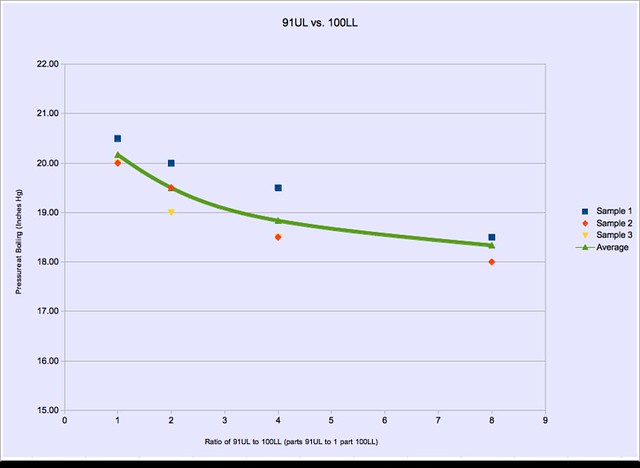ChiefPilot
Well Known Member
Although I had run several tanks of 91UL mogas through my -6A during the winter months, I've been reluctant to do so during the summer months due to fear of vapor lock. While my plane was (and is still) in the paint shop, I thought this would be a good time to learn more about auto fuel in aircraft engines.
One aspect is detonation, and I'm still learning. Another aspect is vapor lock, and this is something that science can help solve. Pete Howell was good enough to stop by last week and demonstrate his simple rig for finding the pressure at which liquid would boil. One trip to Harbor Freight later, I had everything I needed. After talking with Pete and hearing about his and others experiences, I thought I'd test a range of mix ratios. I'd read on here that a small amount of 100ll would affect the vapor pressure of mogas disproportionately so I thought I'd check it out.
I sampled mixes of 1:1, 2:1, 4:1, and 8:1 mogas to avgas. South St. Paul sells both side by side so obtaining the samples was pretty trivial. All tests were done at an ambient temperature of 84ºF after letting the fuel adjust accordingly. Before starting, I measured 100LL boiling at 21" Hg of vacuum and the 91UL mogas boiling at 16" Hg vacuum at ambient temperature. The chart below captures my findings:

The actual pressure values aren't as important as the resulting curve. The curve clearly confirms that 100LL affects the vapor pressure disproportionally to the mixture ratio. With pure 100LL at 21" and pure 91UL at 16", I would have intuitively thought that a 1:1 mix would result in a boiling point of 18.5". The data shows however that a 1:1 mix has a pressure close to that of pure 100LL and that it takes an 8:1 mix to move the pressure to the halfway point between that of 100LL and 91UL.
I invite any comments, suggestions, or additional data on the topic. I think this is pretty cool stuff, and my thanks to Pete for the knowledge and techniques!
Disclaimer: I am not a chemist, I understand that there are various blends and such which may affect the outcomes, and I did not stay at a Holiday Inn Express last night.
One aspect is detonation, and I'm still learning. Another aspect is vapor lock, and this is something that science can help solve. Pete Howell was good enough to stop by last week and demonstrate his simple rig for finding the pressure at which liquid would boil. One trip to Harbor Freight later, I had everything I needed. After talking with Pete and hearing about his and others experiences, I thought I'd test a range of mix ratios. I'd read on here that a small amount of 100ll would affect the vapor pressure of mogas disproportionately so I thought I'd check it out.
I sampled mixes of 1:1, 2:1, 4:1, and 8:1 mogas to avgas. South St. Paul sells both side by side so obtaining the samples was pretty trivial. All tests were done at an ambient temperature of 84ºF after letting the fuel adjust accordingly. Before starting, I measured 100LL boiling at 21" Hg of vacuum and the 91UL mogas boiling at 16" Hg vacuum at ambient temperature. The chart below captures my findings:

I invite any comments, suggestions, or additional data on the topic. I think this is pretty cool stuff, and my thanks to Pete for the knowledge and techniques!
Disclaimer: I am not a chemist, I understand that there are various blends and such which may affect the outcomes, and I did not stay at a Holiday Inn Express last night.
Last edited:




